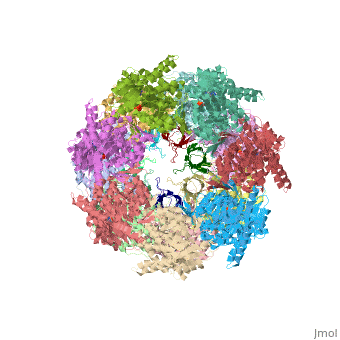User:Gauri Misra/Sandbox 1
From Proteopedia
(Difference between revisions)
| Line 5: | Line 5: | ||
Chaperones bind to the newly synthesized proteins helping them acquire their properly folded 3D structure <ref>PMID: 3112578</ref> Besides, chaperones help in targeting the native proteins to their respective organelles <ref>PMID:3282178</ref><ref>DOI: 10.1002/iub.1272</ref> The first identified chaperones were the histone chaperones that are continously involved in histone metabolism thus regulating genome function, stability and identity<ref>doi: 10.1146/annurev-biochem-060713-035536</ref>. Many protozoan parasites such as ''Plasmodium falciparum'' requires these proteins for cytoprotection <ref>PMID: 14711509</ref> <ref>PMID: 19339102</ref>Chaperones actively participate in the maintenance of proteome integrity, and protein homeostasis (proteostasis) which requires a syncrhonization in various chaperones tuning the process <ref>DOI: 10.1146/annurev-biochem-060208-092442</ref>. | Chaperones bind to the newly synthesized proteins helping them acquire their properly folded 3D structure <ref>PMID: 3112578</ref> Besides, chaperones help in targeting the native proteins to their respective organelles <ref>PMID:3282178</ref><ref>DOI: 10.1002/iub.1272</ref> The first identified chaperones were the histone chaperones that are continously involved in histone metabolism thus regulating genome function, stability and identity<ref>doi: 10.1146/annurev-biochem-060713-035536</ref>. Many protozoan parasites such as ''Plasmodium falciparum'' requires these proteins for cytoprotection <ref>PMID: 14711509</ref> <ref>PMID: 19339102</ref>Chaperones actively participate in the maintenance of proteome integrity, and protein homeostasis (proteostasis) which requires a syncrhonization in various chaperones tuning the process <ref>DOI: 10.1146/annurev-biochem-060208-092442</ref>. | ||
== Disease == | == Disease == | ||
| - | Chaperones are instrumental in protein folding processes. Any alteration in this process leads to protein aggregation and formation of inclusion bodies. Protein misfolding results in various diseases such as Alzheimer<ref>PMID: 16048838</ref>,Cytosolic neurofibrillatory tangles,Parkinson<ref>PMID: 16610362</ref>,Familial amyotrophic lateral sclerosis, Huntington, Spinocerebellar ataxia 1, 2, 3, disease, Spinobulbar muscular atrophy and ageing<ref>doi:10.1111/j.1742-4658.2006.05181.x</ref>. | + | Chaperones are instrumental in protein folding processes. Any alteration in this process leads to protein aggregation and formation of inclusion bodies. Protein misfolding results in various diseases such as Alzheimer<ref>PMID: 16048838</ref>,Cytosolic neurofibrillatory tangles,Parkinson<ref>PMID: 16610362</ref>,Familial amyotrophic lateral sclerosis, Huntington, Spinocerebellar ataxia 1, 2, 3, disease, Spinobulbar muscular atrophy and ageing<ref>doi:10.1111/j.1742-4658.2006.05181.x</ref>. |
| + | <table border=1 cellpadding=1><tr><td> | ||
| + | 2ace</td><td>2.50A</td><td>1996</td><td>NATIVE ACETYLCHOLINESTERASE (E.C. 3.1.1.7) FROM TORPEDO CALIFORNICA</td><td> Harel/Sussman</td><td>Chains=1</td><td>ACH | ||
| + | </td></tr></table> | ||
== Relevance == | == Relevance == | ||
Modulation of chaperones expression is the new therapeutic approach for neurodegenerative and other disease arising from protein misfolding. There is a distinct network of chaperones and co chaperones that either directly influences the substrate proteins or in association with the protein degradation pathways such as the ubiquitin-proteasome-system or autophagy, results in the removal of completely misfolded and pathogenic proteins<ref>doi:10.1186/2051-5960-1-79</ref>. | Modulation of chaperones expression is the new therapeutic approach for neurodegenerative and other disease arising from protein misfolding. There is a distinct network of chaperones and co chaperones that either directly influences the substrate proteins or in association with the protein degradation pathways such as the ubiquitin-proteasome-system or autophagy, results in the removal of completely misfolded and pathogenic proteins<ref>doi:10.1186/2051-5960-1-79</ref>. | ||
Revision as of 08:03, 10 June 2014
'Chaperones'
| |||||||||||
References
- ↑ Ellis J. Proteins as molecular chaperones. Nature. 1987 Jul 30-Aug 5;328(6129):378-9. PMID:3112578 doi:http://dx.doi.org/10.1038/328378a0
- ↑ Deshaies RJ, Koch BD, Werner-Washburne M, Craig EA, Schekman R. A subfamily of stress proteins facilitates translocation of secretory and mitochondrial precursor polypeptides. Nature. 1988 Apr 28;332(6167):800-5. PMID:3282178 doi:http://dx.doi.org/10.1038/332800a0
- ↑ Halperin L, Jung J, Michalak M. The many functions of the endoplasmic reticulum chaperones and folding enzymes. IUBMB Life. 2014 May 19. doi: 10.1002/iub.1272. PMID:24839203 doi:http://dx.doi.org/10.1002/iub.1272
- ↑ Gurard-Levin ZA, Quivy JP, Almouzni G. Histone chaperones: assisting histone traffic and nucleosome dynamics. Annu Rev Biochem. 2014 Jun 2;83:487-517. doi:, 10.1146/annurev-biochem-060713-035536. PMID:24905786 doi:http://dx.doi.org/10.1146/annurev-biochem-060713-035536
- ↑ Matambo TS, Odunuga OO, Boshoff A, Blatch GL. Overproduction, purification, and characterization of the Plasmodium falciparum heat shock protein 70. Protein Expr Purif. 2004 Feb;33(2):214-22. PMID:14711509
- ↑ Misra G, Ramachandran R. Hsp70-1 from Plasmodium falciparum: protein stability, domain analysis and chaperone activity. Biophys Chem. 2009 Jun;142(1-3):55-64. doi: 10.1016/j.bpc.2009.03.006. Epub 2009 , Mar 16. PMID:19339102 doi:http://dx.doi.org/10.1016/j.bpc.2009.03.006
- ↑ Kim YE, Hipp MS, Bracher A, Hayer-Hartl M, Hartl FU. Molecular chaperone functions in protein folding and proteostasis. Annu Rev Biochem. 2013;82:323-55. doi: 10.1146/annurev-biochem-060208-092442. PMID:23746257 doi:http://dx.doi.org/10.1146/annurev-biochem-060208-092442
- ↑ Meriin AB, Sherman MY. Role of molecular chaperones in neurodegenerative disorders. Int J Hyperthermia. 2005 Aug;21(5):403-19. PMID:16048838 doi:http://dx.doi.org/10.1080/02656730500041871
- ↑ Winklhofer KF, Tatzelt J. The role of chaperones in Parkinson's disease and prion diseases. Handb Exp Pharmacol. 2006;(172):221-58. PMID:16610362
- ↑ Chaudhuri TK, Paul S. Protein-misfolding diseases and chaperone-based therapeutic approaches. FEBS J. 2006 Apr;273(7):1331-49. PMID:16689923 doi:http://dx.doi.org/10.1111/j.1742-4658.2006.05181.x
- ↑ Ebrahimi-Fakhari D, Saidi LJ, Wahlster L. Molecular chaperones and protein folding as therapeutic targets in Parkinson's disease and other synucleinopathies. Acta Neuropathol Commun. 2013 Dec 5;1(1):79. doi: 10.1186/2051-5960-1-79. PMID:24314025 doi:http://dx.doi.org/10.1186/2051-5960-1-79

